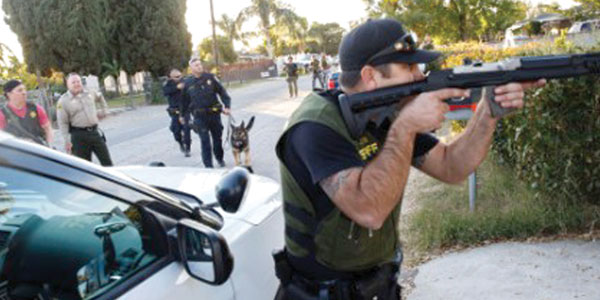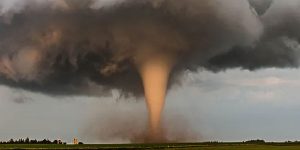Fue un día típico: Me levanté temprano con un poco de “jet lag,” sudé completa la clase de yoga, pagué cuentas, escribí un poco, hice algunas llamadas. Fui al estudio a realizar una entrevista — al chef José Andrés sobre cómo cambiar el mundo con la comida — y un poco más tarde me pasé cinco horas al aire reportando en la televisión sobre la masacre del día en Estados Unidos.
Todo normal.
Las matanzas se han vuelto parte de nuestra vida en este país. La de San Bernardino en California llama la atención porque fue realizada por una pareja, radicalizada y cuya misión con cuatro armas de guerra dejó más muertos, 14, que cualquier otra desde el 2012. Pero, en el fondo, es otra masacre más.
“Otra vez” — así encabezó, con razón, el periódico El Nuevo Herald su cobertura la mañana siguiente. Independientemente de los motivos específicos de esta nueva tragedia, Estados Unidos se ha convertido en el país de las matanzas. Y lo seguirá siendo.
“Tenemos un patrón de tiroteos masivos en este país que no tiene paralelo en el mundo,” dijo el presidente Barack Obama después del ataque. “Debemos unirnos de manera bipartidista, a todos los niveles, para que estos tiroteos sean algo raro y no la norma.”
Pero eso no va a pasar. Ningún candidato presidencial se atreve siquiera a proponer la prohibición de armas de fuego. Y hasta las ideas más razonables — como impedir la venta de armas a gente en la lista negra para vuelos comerciales — son rechazadas en el Congreso. Conclusión: Hay que sentarnos a esperar la siguiente masacre.
En este país es mucho más probable que cada día haya una masacre a que no pase nada. En los primeros 336 días de este año hubo masacres en 209 días, según un análisis del diario The New York Times. Una masacre se define como un hecho violento en que mueren o son heridas cuatro o más personas. Sólo en este año han sido asesinadas 462 personas y 1,314 han resultado heridas en matanzas en Estados Unidos.
La lógica no funciona en este tema. La lógica dice que si hay menos armas disponibles habrá, también, menos masacres. Por más problemas personales, laborales, religiosos o ideológicos que tenga una persona, el daño que puede ocasionar es muy limitado si no tiene acceso a armas de fuego o explosivos. En Japón, por ejemplo, es muy difícil adquirir rifles y pistolas y, por lo tanto, ahí no se registran matanzas.
Este debate debió haber terminado cuando mataron a 32 personas en la universidad de Virginia Tech en el 2007. Pero no pasó nada. Luego, 20 niños y seis profesores fueron asesinados en el 2012 en la escuela Sandy Hook de Connecticut. Y tampoco pasó nada. Al contrario, hubo quienes argumentaron que había que armar a los maestros y alumnos para defenderse.
Estados Unidos es una nación aterrorizada y asediada por las matanzas pero que no se atreve a hacer absolutamente nada al respecto. Las matanzas son tan frecuentes que ya nos sabemos de memoria el ritual de la muerte: Tras los asesinatos hay una búsqueda intensísima de los pistoleros y sus motivos; luego conocemos las historias de las víctimas; habla el presidente en televisión nacional; los políticos prometen hacer cambios; se realizan los entierros y el incidente desaparece en los medios de comunicación en un par de semanas.
Estados Unidos es un país — me consta — que cuando quiere hacer algo usa todos sus recursos para lograrlo. Pero no quiere imponer más control al uso y venta de armas. Los políticos no se atreven. ¿Por qué? Por temor a perder votos, donaciones y su pedacito de poder.
El miedo y la ansiedad se están convirtiendo en algo normal. Ir a un cine en Aurora, Colorado, a una iglesia en Charleston, North Carolina, o a una fiesta de fin de año en San Bernardino, no debería ser una sentencia de muerte. Pero lo fue para decenas en un país donde es más fácil conseguir una pistola que una medicina sin receta.
Lo normal, para mí, es reportar por televisión sobre una masacre casi todos los días. Sólo cambia el lugar y el número de muertos. Y tonta, ingenuamente, cruzo los dedos para que en el reporte nocturno no tenga que incluir entre las víctimas el nombre de alguien que conozco.
(Jorge Ramos, periodista ganador del Emmy, es el principal director de noticias de Univisión Network. Ramos, nacido en México, es autor de nueve libros de grandes ventas, el más reciente de los cuales es “A Country for All: An Immigrant Manifesto.”)
(¿Tiene algún comentario o pregunta para Jorge Ramos? Envié un correo electrónico a Jorge.Ramos@nytimes.com. Por favor incluya su nombre, ciudad y país.)
The Massacre of the Day
Dec. 2 was a typical day for me. I woke up early, due to jet lag. I sweated my way through a yoga class, paid some bills, wrote a bit, returned some calls, then went to the studio to interview chef José Andrés about the ways that food can change the world. A few hours later, I was on television, reporting on that day’s massacre, this time in San Bernardino, California.
Sadly, it all felt quite normal.
Mass shootings have seemingly become a part of everyday life in this country. The attack in San Bernardino stands out because it was perpetrated by a couple who was radicalized, according to the FBI, and whose mission was to use four weapons to leave behind as many casualties as possible. This time, 14 victims were killed, more than any other mass shooting since 2012. The FBI is investigating it as a terrorist act. But in the end, this is just one more massacre.
“Otra Vez” was the headline in Miami’s El Nuevo Herald the following morning — “once again.” The U.S. has become the country of the massacres. And it will remain so.
“We have a pattern now of mass shootings in this country that has no parallel anywhere else in the world,” President Obama said a few hours after the news broke about San Bernardino. “We should come together on a bipartisan basis at every level of government to make these rare, as opposed to normal.”
But that will never happen. No presidential candidate — not a single one — has even dared to propose drastic curbs on the sale of firearms to the public. Even the most reasonable ideas, such as preventing people on the national no-fly list from buying arms, are quickly rejected by lawmakers in Congress because they don’t want to risk going against the National Rifle Association and other gun advocacy groups.
According to an analysis by The New York Times, in the first 336 days of this year, there were 209 mass shootings, which is defined as a violent event in which four or more individuals die or get hurt. This year alone, 462 people have been killed, and 1,314 have been injured in mass shootings in the United States.
These numbers are staggering, but when it comes to guns, logic doesn’t seem to apply. Logic would say that if arms were less easily available, there would be fewer massacres. No matter how many mental health issues a person might have, no matter what warped ideology someone subscribes to, the harm that he could inflict upon innocent victims would be very limited if he didn’t have access to weapons or explosives. Look at Japan, for instance: It’s very hard to buy rifles and pistols there, so, logically, there are no massacres.
This debate over the availability of guns should have ended after 32 people were killed at Virginia Tech in 2007. But it did not. It should have ended in 2012, after 20 schoolchildren and six teachers were killed in a school in Sandy Hook, Connecticut. But, again, it did not. On the contrary, some gun advocates suggested that teachers should be arming themselves after that massacre.
Simply put: The U.S. is a nation besieged by mass shootings, yet officials don’t dare do anything about it. And now, these massacres have become so frequent that we already know the ritual by heart. After the shootings, there is an intense search for the shooters and an understanding of their motivations; then we learn the stories of the victims; the president speaks on national television; politicians promise changes; burials take place; and the tragedy disappears from the media, all in a couple of weeks.
Meanwhile, fear and anxiety are becoming more commonplace in America. Going to a movie theater in Aurora, Colorado, or to a church in Charleston, North Carolina, or to an office party in San Bernardino, California, should not be a death sentence. But it was for dozens of Americans who live in a country where buying a gun is easier than getting some drugs without a prescription.
For me, reporting about a massacre almost every day feels normal. Only the places and the numbers of victims change. So when a tragedy takes place, all I can do is hope that I won’t need to include the name of someone I know when I talk about those who were lost.
(Jorge Ramos, an Emmy Award-winning journalist, is the host of Fusion’s new television news show, “America With Jorge Ramos,” and is a news anchor on the Univision Network. Originally from Mexico and now based in Florida, Ramos is the author of nine best-selling books, most recently, “A Country for All: An Immigrant Manifesto.” Email him at jorge.ramos@nytimes.com.)










